EDSAC 99

EDSAC 1 and after - a compilation of personal reminiscences
As part of the EDSAC 99 celebrations Dr David Hartley collected and edited a informal collection of reminiscences from those involved with the EDSAC and the early days of the Computer Laboratory.
May we encourage anyone else with something to relate to put finger(s)
to keyboard, and put down - in whatever form you wish - your remembrances
of the early days of the Laboratory to add to this collection.
We are interested in anything about
the early years of the Laboratory, experience with EDSAC and so on, up to the
time of the demise of the Titan computer in the early 1970s. We prefer
short rather than long pieces, as these will be easier to incorporate into
an anthology.
You are, of course, welcome to submit a piece in any manner, but we have an
overwhelming preference for something in a machine-readable format.
Submissions in writing will be more difficult to deal with, and we certainly
cannot undertake to capture verbal reminiscences given over the phone. Best would be plain text in an e-mail
message sent to
David.Hartley@ccdc.cam.ac.uk
Please remember to mention your position in the laboratory and to give the dates of your association with it.
We shall assume that anything submitted comes with the author's permission
to be edited and reproduced.
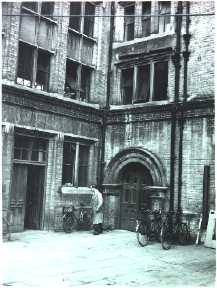
Preface
Foundation
of the Mathematical Laboratory
EDSAC 1
Construction
Maintenance
Operating
Applications
People
Summer Schools
Diploma
students in the 1950s
EDSAC 2
Construction
Maintenance
Operating
Applications
People
Diploma
students in the 1960s
Titan
Construction
Maintenance
Operating
Applications
People
References
Contributors
Preface
I was asked by the Laboratory to collect
and edit, in an informal way, any reminiscences that those involved with
the EDSAC and the early days of the Computer Laboratory cared to submit.
We had been approached by many who would like this to be done, and there
it seemed likely that a small amount of editorial effort would glean a
fascinating amount of historical information that would make interesting
reading.
A general encouragement was made
to those with something to relate to put finger(s) to keyboard, and put
down - in whatever form they wished - their remembrances of the early days
of the Laboratory. We stated an interest in anything about the early years
of the Laboratory, experience with EDSAC &c., up to the time of the
demise of the Titan computer in the early 1970s.
I have ordered the submissions more
or less chronologically, grouping together those that have a common theme;
some have been split to fit this approach. A list of contributors is given
at the end.
Index
Foundation
of the Mathematical Laboratory
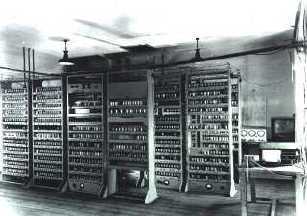
John Lennard-Jones (son of Sir
John Lennard-Jones ScD FRS, founder of the Mathematical Laboratory
My father was a mathematician who had
the unusual distinction of holding a chair of theoretical physics in Bristol
followed by a chair of theoretical chemistry in Cambridge. His main interest
was in atomic and molecular structure, especially the forces between atomic
particles, the nature of chemical bonds and such basic matters as why water,
unlike most other compounds, expands when it freezes. He gathered around
him a research group in Cambridge and his interest in numerical calculations
arose from their work.
To this end he arranged for a working
version of the newly-developed Bush differential analyser to be built out
of Meccano with the help of Mr Bratt and Dr Wilkes. This first machine
which occupied a table top, about the size of a table tennis table, was
housed in the Department of Chemistry. Later, a larger and more sophisticated
machine was built and housed in the new Mathematical Laboratory in the
former Anatomy School. As a boy, I can remember assisting with the input
of data to both machines by moving a transparent cursor over a curve by
rotating two handles on the X and Y axes.
The new Laboratory was open at the
beginning of the War in 1939 and my father offered its facilities to the
needs of arms development. My memory is of a busy department with the Bush
machine in the centre of the building, presumably being used for weapon
research. Later in the War I can remember spending whole nights in the
laboratory as part of the air raid precautions against incendiary bombs
for which we were provided with a "stirrup" pump and pails of water.
As the war developed my father spent
more and more time away from home advising on national projects and was
soon appointed as Chief Superintendent of Armament Research at Fort Halstead
in Kent. Later, he became Chief Scientist at the Ministry of Supply.
When he returned to academic life
after the end of hostilities, his basic research had been brought to a
halt for many years. He began to pick up the threads and also developed
an interest in general principles of education. He accepted appointment
as Principal at the recently founded University of Keele in the early 1950s but his contribution there was cut short by his death at the age of 60
in 1954 at a time when his scientific work was again becoming productive.
Index
EDSAC 1
EDSAC
1 construction
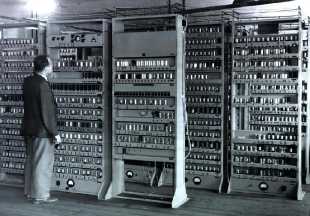
John Bennett (Research Student
1947-50)
Note: This and subsequent sections by John Bennett have been extracted,
with the author's permission, from the Autobiographical Snippets chapter
of In the Beginning - Recollections of Software Pioneers by Robert L Glass
(IEEE Computer Society�, 1998 - ISBN 0-8186-7999-9)
EDSAC was built in a room on the
top floor of a building that was once the dissecting room of the Cambridge
University anatomy school. This historical association brought with it
an advantage and a disadvantage. The advantage came in the form of a large
goods lift that had been designed to carry two cadavers. The disadvantage
became apparent in the summer when the formalin (used to preserve cadavers)
that had impregnated the floorboards over the years was vaporised by the
heat. The smell of the formalin vapour is very penetrating!
Robin Stokes (User/Research Student
1948-49)
I attended a course by Maurice Wilkes
on computing, in which he first taught some useful tricks for efficient
use of such machines, and then went on to explain the general principles
of the design of EDSAC. We were shown the assembly line with girls soldering
military surplus acorn valves into arrays of logic gates, and I was particularly
fascinated by the mercury delay line memory idea.
I did not imagine that fifty years
later I would be using one of EDSAC's descendants, about a million fold
faster and more powerful, to send birthday good wishes from my home on
the other side of the world.
Herbert L Norris (Technician
1951-63)
When working at the Engineering Laboratory
(1940 - 1951), I produced a cylinder of brass about 3" diameter and 6"
long, this was eventually to be covered by a ferrite material and to have
a 'Head' travelling along it which was to read magnetic signals from this
drum. I did not realise that I was in at the beginning of computers.
I was asked if I would like to join
the Maths Lab in January 1951, and I was very pleased to do so. I never
saw the drum working and I believe there was a problem with spraying the
ferrite material on to give an even coat, and the development of the heads
had not progressed enough to be run close to the surface.
I joined Gordon Stevens in the workshops
to do mainly maintenance work on the punched paper-tape readers, tape comparators,
teleprinters and punched paper-tape printers used on the output from EDSAC.
(We fitted mechanical checking equipment to these, which, until replaced
by photoelectric cells, was more trouble than it was worth). These mechanical
devices were working at about 19 characters per second.
Gordon at this time was working
on a memory bank for EDSAC, which was several tubes about 6ft long 1"diameter
1/8" wall, filled with mercury and a crystal at each end. (What would health
and safety say now to the mercury globules in the floorboards?) These memory
banks were kept in a cabinet with fan cooling (more servicing!).
Gordon was promoted upstairs to
an office job in with Eric Mutch. Vic Claydon was brought in from the Engineering
Laboratory. We worked on magnetic-tape drives, and a Mr Willis was interested
in a pneumatic drive system and then magnetic tape drives with electric
motors.
When the small ferrite rings were
used for matrices, we were asked to produce a vibrating pan to deliver
them singly and also supply specimen matrices.
Gordon had started to develop a
tape reader, which I took over. We removed the mechanical lever movement
to make a direct drive and direct brake movement, and then by making Perspex
light guides and lenses we were able to read the holes in the tape by using,
what was then small, photo electric cells (3/16" diameter?). The aim was
to read and stop tape, running at a thousand characters a second, on a
row of holes.
Elliotts produced an improved version
using an anodised aluminium brake pad. Creeds of Croydon brought out a
punched tape printer that ran at a thousand characters per second.
The projects were instigated by
academics, research fellows and engineers; names that come to mind are
of course Dr Maurice Wilkes, Dr Miller, David Wheeler, Bill Renwick, and
David Barron. On the electronic laboratory assistant side we had Sid Barton
(and pipe!) and Wilf Waldock (lay preacher); there were 2 others but I
forget their names. Temporarily on the mechanical side we had Jim Self
(who went off to Manchester, I believe).
John Bennett (Research Student
1947-50)
It was usual in Cambridge for a research
student in his first year to provide cheap labour on a project not necessarily
related to his thesis topic, and my case was no exception. In my first
year, I was responsible for designing, constructing, and testing the main
control unit. This unit sequenced the machine through the cycle of extracting
from the store and decoding instructions (orders, we called them), extracting
operands, initiating individual arithmetical and logical processes, and
proceeding to the next instruction. I also designed, constructed, and tested
the bootstrap facility.
Don Hunter (Research Assistant
1949-51)
Maurice Wilkes stayed late one evening
with a store unit propped on two chairs while testing a gate with feedback
he had heard about at an American conference; a narrow pulse examined the
squared store waveform in the middle of its timing range and the wider
clock pulse held up the output beyond the end of the narrow pulse - phew.
Donald Willis (Research Assistant
1948-50 & 1952-55)
I joined the Maths Lab in 1948 and
was assigned to design an 'auxiliary store' for EDSAC to supplement the
ultrasonic store. Our first thoughts were to base it on magnetic wire that
had been used during the war by war correspondents to record reports from
the battlefield. However in order to achieve a reasonable data transfer
rate this would mean propelling this thin wire at a speed of eight to ten
feet a second, and this was considered too dangerous for use in the computer
room. In the mean time someone showed us a recorder based on magnetic tape
which had been made by Telefunken for the German army, but there was no
available source of magnetic tape. So we constructed a drum which we coated
with an oxide material similar to that used on the tape and mounted on
it a number of writing/reading stations which were moved to different positions
by a lead screw.
Dr Wilkes then fixed me up a job
to work with the new group in Sweden, and I returned to the Maths Lab in
1952. In the intervening period magnetic tape of limited quality had just
begun to be produced so we decided to build an auxiliary store based on
magnetic tape. This required that the 2 thou' thick tape should be accelerated
from rest to full speed rather quickly without breaking it. We did this
by developing a pneumatic capstan that was able to start and stop the tape
at an acceleration of around 50g. The bulk of the tape was held on reels,
and these too could be dangerous if static electricity caused the tape
to be fed outside the boxes rather than in front of the sensors which controlled
the reel servos, as the tape would then be hurled around the room at great
speed. An experimental system was run on the EDSAC and Stan Gill wrote
the subroutines which interrupted the processor when data arrived from
the reading head - a technique which was more widely used later. I left
in 1955 to join Decca Radar to introduce digital computer technology into
radar systems where we used the interrupt system extensively. Decca subsequently
manufactured tape units made on the Maths Lab design and which were used
on EDSAC 2, Leo, English Electric and a number of other British systems.
Some years later I visited an exhibition of computer equipment in Moscow
and was astonished to see a Russian look-a-like using the familiar vacuum
capstans and bridge guide to support the tape.
David Brailsford (Nottingham
University)
During the three years in which I taught
History
of Computing to first year students in my department, I used EDSAC
(and Martin Campbell-Kelly's simulations thereof) as an approachable paradigm
of first-generation computer architecture. I am delighted to report that
the hard core of world-weary, seen-it-all-before hackers — present in almost
all CS classes — were open-mouthed in amazement at David Wheeler's
Initial
Orders 2.
Index
EDSAC
1 maintenance
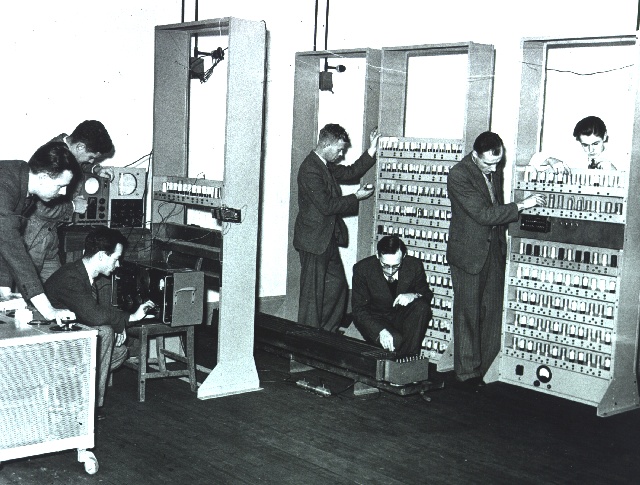
Don Hunter (Research Assistant
1949-51)
I recall leaving a hot soldering iron
directly on the wooden bench and came in next morning to find that Peter
Chamberlain had fastened a bit of wood over the hole it had burnt in the
bench top.
John Bennett (Research Student
1947-50)
Occasionally some contacts on the EDSAC
uniselectors holding the bootstrapping sequence would develop an insulating
film. We soon found a quick, if empirical, cure: an appropriately aimed
carbon tetrachloride stream from the department's fire extinguisher.
Donald Willis (Research Assistant
1948-50 & 1952-55)
I remember while connecting the experimental
tape system to the EDSAC, the door opened and two gentlemen walked in,
one carrying a hand-held aerial and the other a portable receiver. It transpired
that my equipment was radiating electromagnetic energy (the EDSAC room
being on the third floor) and interfering with local radio broadcasting.
So I was required to switch off immediately, which did make it rather difficult
to identify the cause. However I soon discovered that I had omitted to
put in 'grid-stoppers' on to the electrodes of one of the hundred or so
valves and this valve was causing the rather long power line which fed
+250 volts around the five-foot high rack to oscillate at some forbidden
frequency.
Jenifer Leech, previously Haselgrove
(User/Research Student 1953-56)
There was a rheostat up on the wall
just outside the machine room door, which was used to adjust the voltage
if the mains wasn't right. The slider had arrows drawn on it, or on cards
- one pointing upwards labelled 'up' or 'higher' or something, and one
pointing downwards labelled 'down', or something. One day I put on some
other helpful arrows, such as ones pointing left and right, labelled 'left'
and 'right', but they had gone next morning. Well, perhaps it wasn't all
that funny. One night even the rheostat adjustment wasn't enough and Fred
Hoyle, with whom my husband Brian Haselgrove was working on stellar evolution,
rang up the electricity board and said "Can you hike your volts up a bit?".
I can't remember if they did.
Charles Lindsey (Research Student
1953-56)
Until about late 1955 (early 1956),
EDSAC had never worked with its full complement of tanks, so programs were
limited to about 800 words. Then, the tanks were cleaned and refurbished
and the whole 1,024 words became available.
About that time I wrote a program
to simulate the EDSAC on itself so as to detect the length of carries which
occurred in actual programs. The simulator occupied 200 words or so. Though
it was only a couple of months after the refurbishment, I could only find
about 3 working programs under 800 words upon which I could experiment.
D H Shinn (User/Research Student
1947-50)
Although the engineering of EDSAC was
as good as it could possibly be, it contained so many components that it
frequently broke down. During the daytime engineers were on hand, and rectified
such breakdowns as soon as they could. When they left in the evening we
programmers would continue running our programs until the next breakdown
happened, when we would switch off and go home. However, there was an occasion,
probably in March 1950, when EDSAC refused to break down. It continued
working throughout the night. When the engineers arrived in the morning
they were surprised and delighted to find that they did not have to go
through the time-consuming commissioning and testing routine; they just
had to wait until the next breakdown! When they came in, I was the only
programmer left; the others had gone home to have their breakfasts; I soon
went home to have my breakfast, and a good sleep.
Index
EDSAC
1 operating
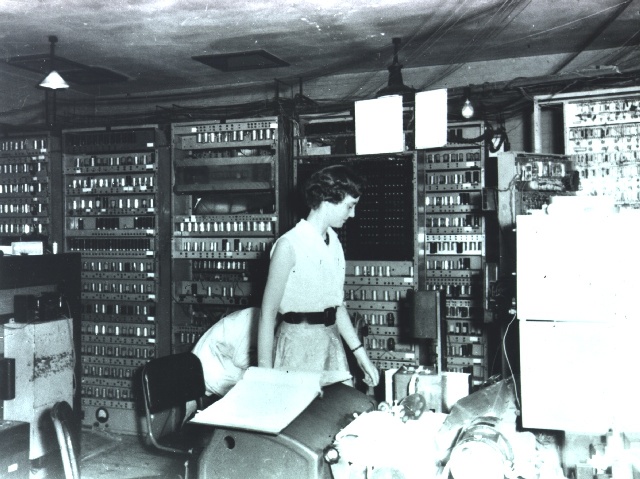
Jenifer Leech, previously Haselgrove
(User/Research Student 1953-56)
The EDSAC 'console' was an old wooden
table; when using the machine one could sit with one's knees under it.
One hot summer night I was working late, wearing shorts. Sleepily I reached
out to the left to put a data tape in the tape reader, and was woken sharply
by an electric shock. A little investigation revealed an unprotected rheostat,
with mains voltage on it, under the table. My bare knee had been pressing
against it.
The unprotected mains had an even
more surprising effect on another occasion. As the EDSAC store wasn't very
large, some of my programs had 'pending-put' tapes, i.e. output tapes with
intermediate results on them which were read in soon afterwards as input
for the next stage. The tape punch used to miss out a hole occasionally,
and when this was detected on input I used to make the correction using
a hand punch which was kept nearby. The punch had once been chained to
a table to stop it wandering, but by then it was loose, with the chain
dangling from it. One day the usual error occurred, time was valuable,
I seized the hand punch, the chain swung under the table, there was a loud
bang, and all the oscilloscope displays went out. I can't remember what
I put in the log book.
As a research student I became an
authorised user, allowed to use the machine alone and switch it off. There
was one unbreakable rule - NEVER switch off the 'oven' which kept the mercury
memory tanks at a fixed temperature. One night the machine stopped working
and I became aware of an ominous smell of burning. I tracked this down
to the oven motor, which was dripping oil on to the floor. I switched it
off, fearing excommunication at least, but I wasn't held to blame.
There were several levels of machine
use authorisation - allowed to use the machine under supervision, allowed
to use it alone and switch it off, and allowed to switch it on. Plus one
unofficial higher level - to achieve enough confidence to turn J.C.P. Miller
off the machine when his time had run out and it was one's own turn. I
think I reached that level in the end.
There was a story about someone
(Sandy Douglas?) going to sleep for several hours one night while the machine
worked on (sometimes it did!), producing tape output. The sleeper woke
up to find a cleaner tearing the night's work off the tape punch and throwing
it away. I don't know if it was retrievable.
John Bennett (Research Student
1947-50)
I remember an April Fool's day prank
from that time. Someone (possibly David Wheeler) arranged a surprise for
one of our colleagues, Ken Dodds, by inserting one extra hole in the paper
tape containing his program. This hole had the effect of transferring control
to instructions that had not been cleared from the EDSAC store. We had
a problem because the queue to use the machine was particularly long that
morning. However, one of us made a grand gesture and surrendered his place
to ensure that the doctored program would run before noon, as was required
by the April Fool's Day ritual. It worked like a charm. Our EDSAC program
printed out: "Ease up Ken, I've been working all night. EDSAC." Our colleague
was not amused!
Don Hunter (Research Assistant
1949-51)
Was it Alec Glennie who made EDSAC
print a message "Hey, I'm tired, I've been working all night" when the
operator started it? There must be more to it than that because pressing
the start button would always cause the same effect.
Peter Wegner (Diploma Student
1953-54)
Mastering the Initial Orders of EDSAC
1 was a rewarding and aesthetically fulfilling experience. This 50-instruction
program was bootstrapped at start-up time and provided programmers with
a sophisticated machine language with relative addressing. The initial
orders were put together in an incredibly clever way to minimise space.
We were very conscious of space limitations during, having only 512 36-bit
words of mercury delay line memory.
Mike Pitteway (Research Student
1956-59)
I was a fully-authorised user of EDSAC
1 in 1956, then EDSAC 2. My wife, Cynthia used to sit up on Friday nights
with me and EDSAC 1, knitting in the middle of it to keep warm1 (there
was a chair in the space once occupied by a rack of valves). She wasn't
so keen on EDSAC 2, feeling that "it lacked character". Peter Swinnerton-Dyer
ran the early evening session, then David Barron and I for the rest of
the night, subject to breakdown.
Index
EDSAC
1 applications
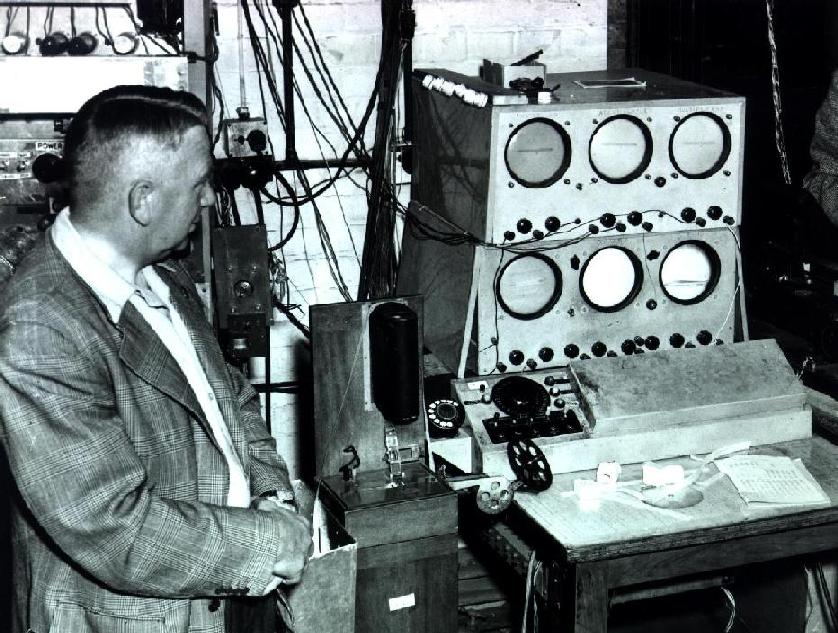
John Bennett (Research Student
1947-50)
The rest of my time at Cambridge was
spent learning some mathematics and working on the computerisation of various
engineering computational procedures for my thesis. I devised one programming
technique that was probably a first - the use of an interpretive scheme.
My reason for using the interpretive technique at that time was to save
space in solving a differential equation using the Runge Kutta process.
EDSAC had a small store by modern standards (initially 256 36-bit words
most - but not all - of the time and no backing store), so every bit was
important.
Robin Stokes (User/Research Student
1948-49)
I was a Ph.D. student (Pembroke) in
physical chemistry in the Free School Lane laboratories in 1948-9. My work
involved a good deal of calculation such as numerical integrations, and
I was the fortunate owner of my own mechanical calculating machine, a Marchant
of about 1920s vintage which is still in working order.
D H Shinn (User/Research Student
1947-50)
I started research in the Cavendish
Lab in 1947 in the group run by Mr J A Ratcliffe, which was concerned with
the propagation of radio waves in the ionosphere. In 1949, I gradually
became aware that there was a machine called EDSAC in the Maths Lab which
would help me in my investigations. I started learning about EDSAC and
writing my program in December 1949. The development of even the simplest
program then took quite a long time, and I obtained the first solid results
from the program in February 1950.
I obtained the first really useful
results just before Easter 1950, and carried on developing these in the
summer. As my last activity in Cambridge in September 1950, I married Jean
in St Edwards Church. We had our Wedding Reception in the Lion Hotel in
Petty Cury, which was shortly afterwards pulled down to make room for a
large new development.
The results which I obtained from
EDSAC were incorporated in my thesis, and published in the Journal of Atmospheric
and Terrestrial Physics. I think that I obtained my PhD degree not because
of the quality of my mathematics or physics, but because my thesis was
one of the earliest which incorporated the results of a computer program;
I don't think that my examiners understood much about computer programs!
I have spent the rest of my working life with radio waves and antennas.
This has been exciting, and much helped by three significant inventions
which started between 1949 and 1957, namely transistors, satellites, and,
thanks to Maurice Wilkes etc, computers.
Jack Harwood (User/Research Student
1949-50)
Between 1947 and 1950 I was a research
student at the Cavendish, studying the propagation of low-frequency radio
waves through the ionosphere. Part of the work involved taking simultaneous
pen-recordings of the varying signal amplitudes received at two stations
a few kilometres apart, and then calculating correlation coefficients between
these for groups of a hundred or so paired readings. The computations involved
lining up the two columns and calculating sums of squares and cross products,
then repeating this for about 20 relative vertical shifts of the two columns.
I wasn't sure at the time whether
Dr Wilkes had a program already written for performing these calculations,
or whether one was specially written for the purpose — but looking at the
reproduction, on your web site, of the log entry for 1949 May 6, it looks
like the former, and my work must have come up not a lot later than that
first entry, as my period at the Cavendish ended in mid-1950.
Anyway, the outcome was that Mr
Ratcliffe arranged for me to be invited over to the Mathematical Laboratory,
where I spent several happy hours typing the data onto punched tape, and
then was helped to feed these rolls into a reader attached to the big machine
itself. If I remember correctly, it took about 10 minutes for the a tape's
data to be fed through the mercury delay tanks and the EF50s and come out
with all the summations, and I was very pleased with the final results
and the effort it had saved.
The assistance given by Dr Wilkes
and the Mathematical Laboratory, by the way, was acknowledged in my eventual
PhD thesis in 1951 and in a subsequent IEE paper published in 1953.
Don Hunter (Research Assistant
1949-51)
I still have a ribbon (tweeter) loudspeaker
horn calculated on EDSAC because I did not know the closed form of the
solution giving the shape of the sides. These were bent on the metal rolling
machine by Bill Renwick, presumably during the lunch hour.
Leonard Dresel (User/Research
Student 1949-52)
I was a regular user of EDSAC 1 from
1949 to 1952 as a postgraduate student under Dr S.F. Boys, and I contributed
the subroutine V1 published in the book by Wilkes, Wheeler and Gill in
1951. I also served as a demonstrator on the programming Summer Schools
held in 1950 and 1951.
Geoff Cook (User/Research Student
1951-53)
Colin Reeves (User/Research Student
1952-55)
In the early 1950's, all the user groups
around the EDSAC were enthusiastic about exploiting this new tool within
their different disciplines none more so than the theoretical chemists
under the leadership of Dr Frank Boys. He had many deep insights. One of
the most significant was that computer usage was not confined to large-scale
arithmetic operations but could also encompass algebra together with a
range of symbol manipulations. Thus the EDSAC was used to generate automatically
the complex formulae (some consisting of hundreds of many-variable terms)
for the three-and six-dimensional integrals that are required in fundamental
quantum-mechanical calculations of molecular structure. The computer representation
of these formulae was used directly in the subsequent evaluation of the
integrals for a particular molecule under consideration.
We are very glad to have participated
in some of the first fundamental calculations of molecular wave functions
and remain grateful for the facilities that were provided by the Mathematical
Laboratory.
William Cochran (User 1946-64)
From 1946 to 1964 I was a member of
the Crystallography Group in the Cavendish Lab and an intermittent user
of EDSAC 1. Sometime in the mid-1950s, A.S. Douglas and I published in
Proc. Roy. Soc. a method for the direct determination of crystal structures
using EDSAC. As far as I know it was the first such proposal for the use
of a computer for this purpose. I must admit that in practice it was not
very successful as it was beyond EDSAC's capabilities. Later others were
very successful using related methods, particularly a former colleague,
M.M. Woolfson, also an EDSAC user, and who retired as Professor of Theoretical
Physics at York University not long ago.
Index
EDSAC
1 people
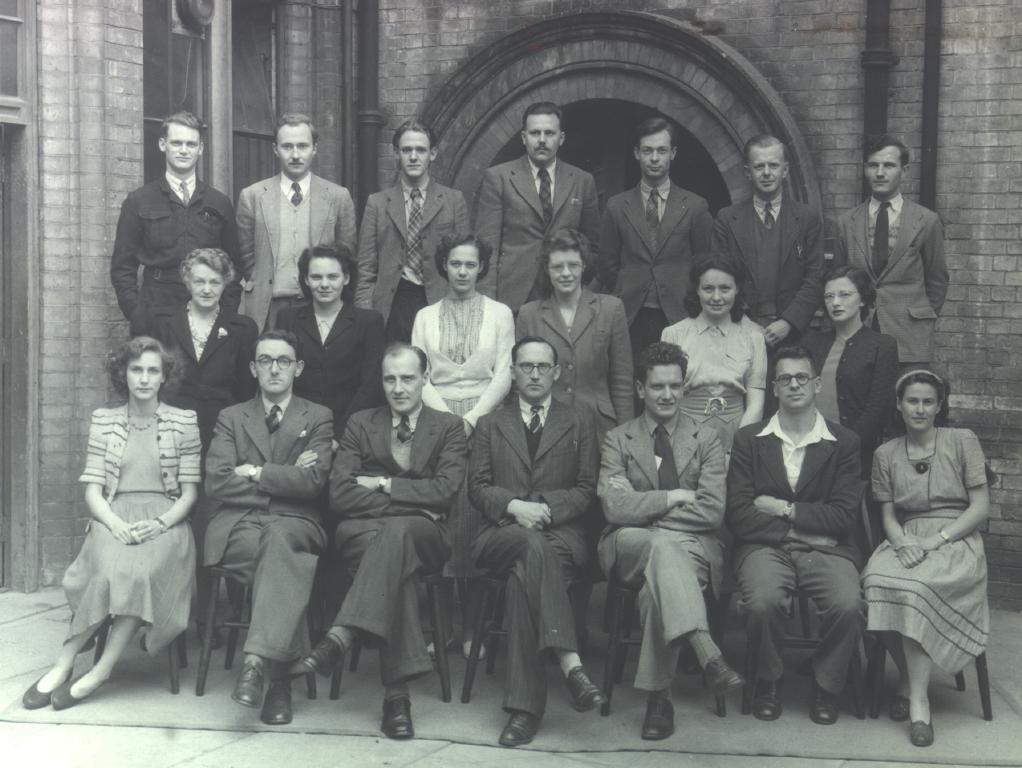
Don Hunter (Research Assistant
1949-51)
Bram Loopstra from the Matematisch
Centrum in Amsterdam spent three months or so at the Maths Lab and returned
from a visit to NPL gleefully waving a Pilot ACE chassis.
Neil Breakwell (Undergraduate
1948-49)
It could have been 1948 or 1949, when
I was a Selwyn undergraduate reading for the Natural Sciences Tripos, that
I was given a guided tour of EDSAC and its racks of valves and other components,
and also shown the small (separate) differential analyser, by the then
operator of EDSAC, a young mathematics graduate from Pontefract, West Riding
of Yorkshire named Eileen Emily Caroline McKee, whom I subsequently married.
Don Hunter (Research Assistant
1949-51)
Someone tried to convince Eileen McKee
that there was a mouse in the paper tape bin.
D H Shinn (User/Research Student
1947-50)
We all owe a great deal to Maurice
Wilkes. I also remember with gratitude David Wheeler. He spent a fair amount
of his time in 1950 writing and testing subroutines for the rest of us
to use; we couldn't possibly have managed without his subroutines. Another
programmer whom I remember well is Tony Brooker. He came to Cambridge in
order to work on a machine called a Differential Analyser. This machine
could be described as Wheels Within Wheels — a remarkable achievement in
precision mechanical engineering, designed to provide analogue solutions
to differential equations. Tony, being a bright lad, soon discovered that
EDSAC was a much more effective tool for dealing with differential equations,
and abandoned the Differential Analyser. He later became a professor at
Essex University. Also working on the EDSAC in 1950 were Francis Crick
and John Kendrew from the crystallographic department of the Cavendish
Laboratory. I had no idea then that their work would become so important
for absolutely everybody. They, like all the other programmers, were very
pleasant people to deal with. And we must not forget J.M.M. Pinkerton,
who went to work for the caterers J. Lyons on the commercial applications
of computers; that subject has advanced quite a lot in the last fifty years!
George Felton (Undergraduate
1946-51)
When I was a maths student at Cambridge
in 1946-51, I attended numerous Thursday colloquia in the Mathematical
Laboratory and followed the design and construction of EDSAC with intense
interest. I got to know Maurice Wilkes, David Wheeler, Stan Gill and many
others.
I continued to attend colloquia
after I went down, when I was employed at Elliott Brothers, and later Ferranti
and ICT/ICL, on the design and programming for the Elliott Nicholas Computer,
Pegasus, Orion, 1900-series (where I was responsible for the George Operating
Systems), planning the ICL 200-series, etc.
Donald Willis (Research Assistant
1948-50 & 1952-55)
Dr & Mrs Wilkes traditionally hosted
a Christmas party for the children of staff and a number of sketches were
provided for entertainment. One of these, in around 1952, was a parody
on a popular BBC programme of the time for children entitled 'Listen with
Mother' which began with the words "Are you sitting comfortably? - Then
I'll begin." The sketch was, of course, called 'The Microprogramme'.
Charles Lindsey (Research Student
1953-56)
Sid Barton and Wilf Waldock were the
Departmental Matchmakers, and regarded the marriage of Eric Mutch and Margaret
Lewin as their crowning achievement (though they admitted that Sylvia (Rossiter)
and myself managed perfectly well without their assistance).
Jenifer Leech (previously Jenifer
Haselgrove) (User/Research Student 1953-56)
I was in the Maths Lab working on EDSAC
1 in 1953-56 as a research student in the Radio Group of the Cavendish
Laboratory, also doing some part-time work for them. My first husband,
Brian Haselgrove, was a Senior Assistant in Research in the Maths Lab at
the time, and John Leech, later my second husband after Brian's death,
was a research student. Brian had done some vacation work as an undergraduate
towards the building of EDSAC (an unsuccessful attempt at a piece of test
equipment, I believe), perhaps John too. My son, Richard Haselgrove did
the Computer Science Diploma in 1973-74.
Mike Pitteway (Research Student
1956-59)
We both got to know Eric Mutch well.
I remember his sister (or was it his sister-in-law?) at one of their parties
wearing nothing but an un-stitched roll of cloth to win a bet. She made
it without impropriety (just).
Also a night when Peter Swinnerton-Dyer
introduced us to the music of Tom Lehrer during an EDSAC party. There were
the remnants of an unfinished barrel of Greene King, and the engineer (Bill,
if I remember rightly after all these years) agreed to barrel sit, and
I returned early Sunday morning to be greeted by the soft sounds of distant
singing.
Oliver Wintringham (Decca Radar)
Perhaps the most surprising thing about
EDSAC, for me, is that I did not hear about it, nor suspect its existence,
while reading Mechanical Sciences (with a part II in Electronics) from
1949 until 1953. I was actively looking for a branch of Engineering that
would be as interesting as the Army (where I had studied digital radar
equipment and selsyns) was, but I nearly missed computers, since neither
I nor the Appointments Board had heard of them!
I am pleased to say that I have
been working as a computer engineer, on hardware, systems and software,
ever since.
Peter Gray (Undergraduate 1958-61)
I was a Cambridge undergraduate in
Natural Sciences who actually ran his Xray practical data though EDSAC
2 in 1961, got hooked, did a PhD in high energy physics with computing,
and has been computing ever since.
Index
EDSAC
Summer Schools
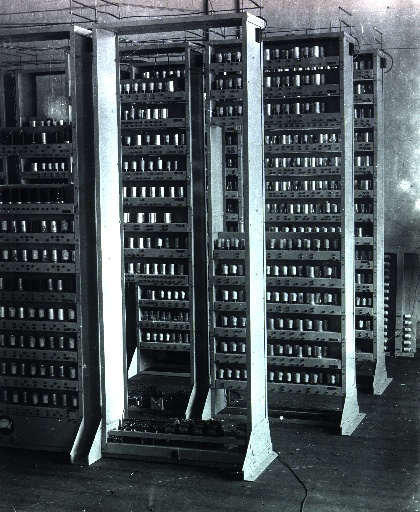
Durward Cruickshank (Summer School
1950)
In September 1950 I was appointed Lecturer
in Mathematical Chemistry in the University of Leeds. As my first task,
my boss Professor E. G. Cox sent me to the Cambridge Summer School on Programme
Design for Automatic Digital Computing Machines. I believe this was the
world's first summer school on electronic computing. Cox led the chemical
crystallography group at Leeds. He had been a pioneer from 1937 onwards
of X-ray structure analysis by Fourier methods with three-dimensional data.
The Leeds laboratory was strong in computing by punched-card methods. Cox
was keen to exploit new ways for handling ever-larger crystallographic
calculations.
My recollection of the ten-day School
is that there were some 20-24 participants of varying seniority. We were
given the September 1950 issue of the Report on the preparation of programmes
for the EDSAC and the use of the library of sub-routines. I still have
my copy and also my manuscript notebook. It shows lectures on the following
topics. To indicate the relative sizes, I show in parentheses the number
of my pages on each topic.
D. R. Hartree: Numerical Analysis
(15 pages)
S. Gill: Programming (21)
R. A. Brooker: Logical Design of
the EDSAC (5)
D. J. Wheeler: Sub-routines (13)
S. Gill: Checking Routines (4).
Evidently numerical analysis was considered
a pre-requisite to good programming. There were two external speakers
J. N. Wilkinson: Programming for
ACE (3)
T. Kilburn: Programming for the
Manchester Machine (6).
The final General Discussion opened
with a description by M.V. Wilkes of developments in the USA (3 pages).
The participants by then had realised how splendid was the success of the
Cambridge team in bringing EDSAC into working operation in 1949.
I have lost my copies of the programming
exercises we were given. By the end of the School some of the students
were running their own problems on EDSAC. One Dutchman found that a certain
20-decimal number was factorisable. He was lucky. He got the first factor
in 15 minutes. If the number had been prime, the run would have taken 12
hours.
One student who made no attempt
to do the exercises was B.V. Bowden, who had done his Ph.D. in Rutherford's
lab and was now computer salesman for Ferranti. Vivian's objective in the
exercise periods was to chat individually to the participants about the
computer Ferranti was building in Manchester. This was the commercial version
of the first electronic stored-program computer, built and run by F. C.
Williams and Tom Kilburn in 1948 using cathode-ray storage tubes.
I owe a double debt to the 1950
Summer School. It introduced me to the principles of computer programming,
machine order codes, binary arithmetic etc. Through Bowden the School introduced
Cox and myself to the Manchester project. From 1952 to 1957 the Leeds crystallography
group made very heavy use of the Ferranti Mark I computer. When Leeds University
bought a Ferranti Pegasus in 1957, it chose Sandy Douglas from Cambridge,
also a participant in the 1950 Summer School, as its first Director of
Computing. In 1967 Vivian, by then Lord Bowden and Principal of UMIST,
invited me to move from Glasgow to Manchester.
Dick Grimsdale (Summer School
1950)
I attended the Summer School in Programming
in 1950 and wrote my first program on the EDSAC 1. From 1960, I was working
on computer developments in Manchester and in those days the community
was very small and so we all knew each other.
Edsger Dijkstra (Summer School
1951)
My memories of my visit to the programming
course in September 1951 are mainly non-technical: this trip was my first
visit to a foreign country and as such it was an overwhelming experience.
In Cambridge I lived in a student
house with about 30 rooms. In a letter to my parents I described the landlady
as 'an angel', but I remember that when I came home I had to play the piano
and then to accompany her while she sang. It took me some time to realise
that usually she was slightly drunk.
I also remember an early Sunday
morning when I realised that I had eaten my (still rationed!) bacon raw,
and that I should not have done so as it might be trichinous. (During the
war we had been warned for that possibility.) I still see myself walking
through the cool, still deserted streets of Cambridge until I had found
a hospital, where I told the person I encountered "I might be poisoned".
When I had gone in a little bit more detail, I was told that English bacon
was safe....
Once when Wilkes was lecturing,
he wanted to show an example and asked the audience to choose between the
calculation of a definite integral and the numerical integration of a differential
equation, but the British audience was too polite to push its preference.
I had a preference because I was not too sure what differential equations
were; deciding to break the deadlock I said in my best English "I feel
like a definite integral". Wilkes spontaneously reacted with "Well, you
don't look like it!" and everybody laughed; Wilkes immediately corrected
himself and added "What you said was perfectly all right, only we don't
say it."
I also remember the lecture by Tony
Brooker who had been invited as guest speaker. In the academic environment
in which I was growing up, I had never heard a Dutch speaker lecture with
a regional accent; this was simply not done. You can imagine my consternation
when I was exposed to a lecturer whose accent was so strange and unfamiliar
that I could hardly understand him! (From the lecture I don't seem to remember
much more than that he used lots and lots of slashes //////.) Eventually
I asked my neighbour whether he knew to what kind of English we were exposed;
he listened carefully for a short while and said, "My guess is 16 years
of Manchester superimposed on 16 years of cockney." I felt vindicated.
I never checked it.
My greatest scientific excitement
was probably caused by the subroutines E2 (for the exponential function)
and L1 (for the logarithm), E2 because it was so ingenious, and L1, because
it was so simple and such an eye-opener. (It still is.)
Because my father was quite familiar
with Hartree's work, the latter is mentioned in a letter to my parents.
In that letter I found that the participants were split into groups of
half a dozen or so, and that I was not in Hartree's group, but in Wilkes'.
I wrote my parents that one day Wilkes remarked to me "Ah! You are a bright
boy!" In retrospect, I think that the general consensus is that, once more,
Wilkes had been right.
It is no exaggeration to say that
those three weeks in Cambridge changed my life!
Index
Diploma
students in the 1950s
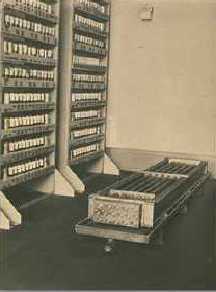
Peter Wegner (Diploma Student
1953-54)
In the spring of 1953, I was completing
my BSc degree in mathematics at Imperial College when Douglas Hartree gave
a visiting lecture and persuaded me to come to Cambridge for the summer.
I worked with him on a problem that involved collaboration with Peierls
in Birmingham and the two young physicists Jerry Brown and Sheila Brenner.
This problem involved solving differential equations with Bessel function
right-hand sides by the Runge-Kutta-Gill method. I was able to simplify
the solution procedure by representing the Bessel functions by differential
equations rather than tables, solving a larger set of differential equations
without the need to resort to tables and interpolation. The idea of replacing
laboriously computed tables by differential equations seemed counter intuitive,
but simplified and speeded up the solution process.
One of my early assignments was
writing a program for solving linear equations. I was fascinated by the
ability to look at the memory content while the computation was progressing
and watch successive data values being zeroed as a part of the elimination
procedure. I was sloppy in providing test data for the equation-solving
program and ran my first test with two identical rows, which should have
caused the program to crash on division by zero. However, round off error
came to my rescue and I watched the program divide by 2**-35 and provide
a solution of rather large numbers that, on back substitution, provided
a satisfactory solution to several decimal places. Thus, I was able to
successfully invert a singular matrix.
Our first Diploma class in 1953-54
consisted of three students. The other two were Albasini, who subsequently
worked in the national Physical Laboratory on numerical analysis, and Stan
Bootle, a colourful married student with a family of five children whose
door was always open to my visits, and who later became quite a well-known
radio personality.
I still have my diploma thesis,
with over 100 yellowing pages that include chapters on the Initial orders,
the differential equation problem, and philosophical chapters on computation,
which are dated but include a discussion of software complexity, systems
with multiple interfaces, and other topics that later became important
areas for technical analysis
Maurice Wilkes had a strong influence
on my intellectual development. Recognising my inclination towards philosophy,
he asked me to look into the work of Leibniz on early calculation, and
I translated an article by Leibniz from German into English. I have greatly
valued my continued contact with Maurice over the years, meeting with him
several times a year during his years in Boston working for DEC.
Cambridge was an exciting place
in the 1950s. I organised a small philosophical study group with Amartya
Sen, who recently won the Noble prize in Economics for his work on world
hunger. I often went to tea at the Cavendish Laboratory, where they sold
delicious cakes for two pence each, and attended the quantum theory lectures
of Dirac. In the evenings I often ate at the local ABC restaurant and remember
having dinner there with Francis Crick on a couple of occasions. On one
occasion, I was "progged" by a bulldog and two proctors for not wearing
a gown after dark. I had to pay thirteen and four pence because I was a
graduate student (the fine for undergraduates was six and eight pence).
I lived in an attic in the vicarage at 45 Jesus Lane, right opposite the
entrance to Jesus College.
My short, one-year stay, at the
Maths Lab played a key role in my professional life whose importance I
am only now beginning to appreciate. After Cambridge, I spent a short time
in Manchester working with Brooker, and later became a part of the brain
drain, working on time sharing at MIT, returning to the London School of
Economics to work on operations research, and then back to the USA to work
on programming languages, semantics, and software engineering.
Christopher Phelps (Diploma student)
I was one of the users of EDSAC 1 when
it was in its youth and when, I think, Jenifer Haselgrove was trying to
make a tape unit work. I took the Diploma course and still have a copy
of the dissertation I wrote, supervised by Sandy Douglas, about cyclic
solutions to ODEs. I used EDSAC routinely, that is to say every normal
working day (as students do).
Diana Belcham (Diploma student
1956-57)
In 1956-57, I was the only female Diploma
student (as Diana Catton). One outstanding memory of the year is the encouragement
of my tutor, J.C.P. Miller. The Diploma was a stepping stone to a generally
enjoyable career in computing.
Index
EDSAC 2
EDSAC
2 construction
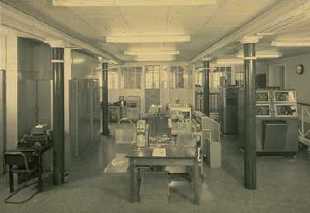
Charles Lindsey (Research Student
1953-56)
Maurice would come in, see that the
power was on and say: "Oh, good! I see we are making progress!".
Bill Renwick would come in, see
that the power was off, and say: "Oh, good! I see we are making
progress!".
(The point being that the bug last
found when the power was on had been identified , and was now being fixed).
Oliver Wintringham (Decca Radar)
I was in the team at Decca Radar, under
Donald Willis, that made the Decca Twin Tape Unit. The technology had been
developed at MIT and then in the Cambridge Mathematical Laboratory and
the first magnetic tape unit from our production line was sold to Cambridge,
to attach to EDSAC 2.
In 1957, or perhaps 1958, I arrived
with the tape unit, to see it safely installed upstairs in the Mathematical
Laboratory, on Corn Exchange Street. It was the size and weight of an upright
piano, so we were grateful for the help of several Maths students who also
rowed. They manhandled it up the Gothic staircase.
Magnetic tape was an exotic new
peripheral then and this was the first drive available in the UK. Our market
place, outside the universities, was the eleven competing UK computer manufacturers
(Leo, Ferranti, English Electric, Vickers, British Tab. and so on).
In some conditions, the magnetic
tape clung to the metal guides, and was damaged. On my second or third
visit, I brought a message to the Mathematical Laboratory: "Try boiling
a kettle, to increase humidity, and so reduce static". I was sent back,
with a message to Decca Radar: "At that price, we expect to find the kettle
built-in".
Peter Toye (Archimedean 1963-66,
Diploma Student 1966-67)
A reminiscence that Eric Mutch told
me, not long before his death.
When they were installing EDSAC
(I think 1, maybe 2), he commented to the engineer who had been responsible
for the strengthening of the building that he hoped that the building would
take the weight. The engineer responded, saying that he'd multiplied Eric's
weight estimate by 10 before doing the specification. Eric's comment was
"That should be all right, then. I multiplied mine by 10 before giving
them to you."
Index
EDSAC
2 maintenance
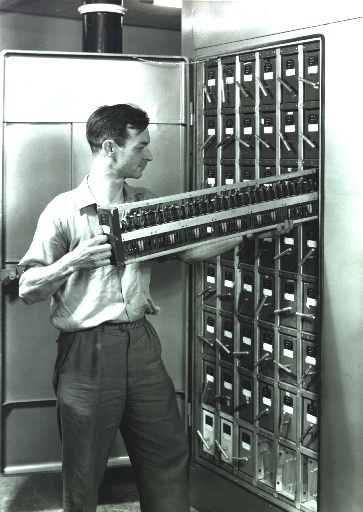
Roy Bayley (Computer Engineer
1962-73)
The late Eric Mutch hired me to work
on the Titan commissioning team so I have little experience of EDSAC 2.
However, I did help out on EDSAC 2 from time to time and I found it a scary
machine. In fact, my earliest memory of the Maths Lab involves being present
when an EDSAC 2 unit burst into flames. This apparently was a common event
and Peter Bennett calmly reacted by using a fire extinguisher to put it
out.
For those unfamiliar with its layout,
working on EDSAC 2 could be dangerous. The machine had many bare terminals
and wires carrying up to 350 volts. You needed to be very careful where
you put your hands and preferably keep one hand in your pocket!
Index
EDSAC 2 operating
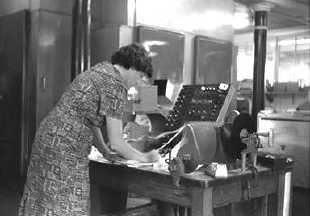
John Lindley (Diploma Student
1958-59)
- the incredible difficulty we had
ever to produce a single correct piece of paper tape with the crude and
unreliable home-made punching, printing and verifying gear available in
the late 50's.
- dropping the inside out of one
of J.C.P. Miller's precious Prime Number tapes and having somehow to disentangle
it without wrecking it. Life is much simpler in some ways these days.
- the experience in the middle of
the night sometimes of working alongside some of the famous names in Cambridge
Science all vying for time on EDSAC 2.
Elizabeth Waldram (User 1959-65)
The loudspeaker enabled you to listen
to the progress of your program and, in particular, to detect the dreaded
'closed loop'. A repetitive pattern alerted the other members of the queue,
and it was then a question of how long you could endure their quizzical
glances, before admitting defeat and retiring to try and sort out your
code in time for the next test period.
Peter Fellgett (User 1962-65)
Being a valve machine, EDSAC 2 would
fail every few hours. The daily routine was that the engineers kept it
working during normal hours, after which it was available for use so long
as it remained serviceable, which might be after a half an hour or so,
or else extend into the small hours. There were two classes of users, "fully
authorised" who could be in sole charge of EDSAC 2, and "semi authorised"
that could use the machine in the presence of a fully authorised user.
At night, we used to congregate on the EDSAC 2 floor and sit on the rather
with-it studio couch that was there. There was always a bit of tension
about whose turn it was, but this resolved when Teddy (Sir Edward) Bullard
turned up and asked a few questions about what order we were in. He was
a great personality.
There were (I think) three program-testing
periods each day, each of 10 minutes duration. We would queue to feed our
program tape into the reader, and the most usual result was the dreaded
report-stop. If you tried to call a non-existent order, call an unset modifier
register, overflow the accumulator, or try to take the square root of a
negative number, etc. a precise machine-action had to follow, usually the
report stop. This was irreversible, and printed out a little diagnostic
information such as the store-location of the order causing the stop, the
content of the accumulator, etc. The social pressure to get off the machine
quickly was of course enormous. You then tried to find the error in your
program, correct your tape, and go back for another go. Some people achieved
as many as three tries in the 10-minute period. People today who program
by clicking a mouse really do not know what life is about!
An abiding memory is of a woman
emerging from her office and declaiming to the assembled multitude: "I
want a man, with long strong arms." It emerged that she had lost
a program tape down the back of a heavy desk.
Judy Thomas, formerly Bowers (Operator
1961-67)
There were frequent fires in the valve
chassis and I always wanted to reach the fire extinguisher first but never
made it, the engineers arriving before me. The smell was quite unique;
as soon as one entered the building one knew the computer would not be
working and there would be the notice at the top of the stairs - M/C OFF
Come back in so many hours. One fire destroyed the ferrite core store and
EDSAC 2 was down for weeks. We (the operators) had to help the engineers
wire these ferrite cores back again - very fiddly and it took hours (days
in fact). Sid never did allow us to solder them back onto the boards (that
would have been much more fun).
There were certain times in the
day when students and staff operated the machine themselves. There was
a queuing system whilst we operators had our morning coffee and afternoon
tea on the floor below. Otherwise, we ran their programs ourselves: short
ones first followed by the longer ones hoping they wouldn't fail whilst
we did other things. The evenings and nights were booked for even longer
jobs that users ran themselves.
Philip Ekstrom (Diploma Student
1963-64)
After a virtuous beginning on the antique
Brunsvegas, and since Atlas was still not ready for our use, practical
computing centred on EDSAC 2. We prepared punched paper tapes with our
programs and data on them, queued up in front of the console, and waited
as the operator fed each of our tapes into the reader. We would collect
the resulting output tape (if any!), find a free teleprinter, and print
out the results. I recall a contest among several students to produce the
shortest self-replicating tape.
By then a 'backing store' of 16K
words had been uneasily grafted onto the machine, so the original 1K memory
limit was eased for data, though programs could still be executed directly
only out of the original 2K (half-word instruction) store.
Being familiar with contemporaneous
American computer technology, I noted several differences of style. Magnetic
tapes at home were simpler media written sequentially in contrast to the
block-addressed tapes I encountered at Cambridge. The electronic technology
in EDSAC 2 (soon to be turned off) was by then old, but its design seemed
to me extremely clever at getting the greatest possible performance out
of a minimum in hardware. Especially appealing were the routines in "fixed
store" which had a great deal of sophistication compressed into a very
few instructions and using very little workspace. They let the machine
come up much smarter and friendlier than any I had previously seen.
Karen Sparck-Jones (User1964
— Reader now)
I was around the Lab during most of
EDSAC 2's time, though I was not myself a user (I had some experiments
using EDSAC run for me by Roger Needham).
The second floor area where the
operating console was had a definite character, especially on the evening
and night shift, combining earnest dedication and cheerful camaraderie.
The evening rota dated June 1962 which survives includes e.g. Birch, Bullard,
Swinnerton-Dyer and Wheeler for Thursdays, Matthewman, Mutch and Needham
for Fridays. The central part of the room, with the console, was surrounded
by a raised walkway and offices. There was also the 'user area', from which
the well-known 1960 photograph was taken. This alcove was furnished with
the user name queue, a home-made gadget into which users fed their name
tags to claim their operating turn; a large grey and red sofa; and stacks
of miscellaneous non-computing reading material including science fiction
and the Memoirs of Lady Knightley of Fawsley, a member of the Victorian
gentry and luminary of the Girls Friendly Society. Though the sofa was
quite restful, the user area was definitely deprived by modern standards,
since there were no vending machines.
Rachel Wroth, formerly Britton (Diploma
student 1965-66)
My earliest memory of the Laboratory
was the funeral of EDSAC 2. A room full of people, many dressed in black,
a wreath made from paper tapes, a funeral oration and the last post — I
could not understand why so many around me were reacting so emotionally.
As a newcomer, I had never used that machine and thought it was just a
rather ugly large piece of laboratory equipment. I soon came to realise
why so many had become so attached to it and how important its development
was to the future of computing.
Richard Jennings (Diploma student
1962-63, Ferranti)
I wrote a Music Compiler for EDSAC
2 which was used at the close down ceremony for that machine. I have some
old (reel-to-reel) tapes of earlier runs of some of the music used on that
occasion, which I hope to transfer to cassette early next year.
Index
EDSAC
2 applications
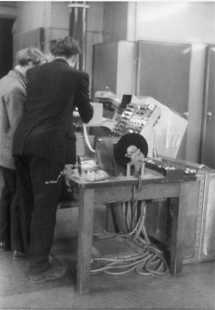
Elizabeth Waldram (User 1959-65)
There were computer graphics
before 1965! I wrote some of the very early graphics software on Edsac2
(1961-62) for displaying and photographing radio-astronomy maps on the
cathode ray tube, which was then the fastest form of output. The plots
were essentially 'slices' through the sky brightness distribution and preceded
the early contouring algorithms on which I also worked.
Peter Fellgett (User 1962-65)
Looking back, one sees what an enormous
conceptual advance EDSAC 2 represented in being a binary general-purpose
machine. Many people at the time had great difficulty in getting their
minds around the idea of a machine whose internal structure would be unaltered
whether it was finding prime members or doing Fourier transforms. Surprisingly,
probably because appreciation of the problem went down to a lower level
of imagination, many people seemed to have even more difficulty with the
idea of a machine working in binary. Machines were built at this time with
hardware radix 10 arithmetic, and even hardware variable radix to deal
with the arbitrary radices of pre-decimal currency and Imperial weights
and measures. Being dyslexic, as there is evidence Alan Turing was, may
predispose against this raid of error.
Fortunately, EDSAC 2 users were
spared two of the major incubi of computing, FORTRAN and punched cards.
We programmed in clean machine instructions, what would now be called assembly
language although to logic of not calling this machine language is dubious.
With 1,000 ch/sec readers, punched paper tape was an excellent medium,
cheap, compact and perhaps above all robust. One user successfully read
a tape he had accidentally sent to the laundry in the pocket of his shirt,
whereas the slightest scuffing of the edge of a card could spell trouble.
Moreover with tape, you cannot drop the deck of cards.
With a core-store of 1K words and
a time for floating-point multiplication of (I think) 250 microseconds,
great store was set by economising orders. There was a saying that given
any program, David Wheeler could do it in fewer orders. This might seem
to lead by iteration to an absurdity, but to anyone who had seen what David
could do to a program, the absurdity was far from obvious. A machine with
such a small store and slow speed might seem almost unusable to today's
prolix programmers, but it opened up fields of investigation which had
hitherto been inaccessible.
Not the least of these new fields
was the extension of X-ray crystallography from simple inorganic crystals
to large organic molecules, leading in the hands of Perutz, Kendrick, Franklin
and others to the elucidation of the structure of DNA. X-ray crystallographers
were not however over-popular with other users since their programs were
output-limited. The machine was thus tried up for much time acting as nothing
more then a computer for a printer or punch.
After I left Cambridge to go to
Royal Observatory Edinburgh, I was allowed to continue to use EDSAC 2.
I made one visit hoping to run a small job, and as I walked into the Maths
Lab was greeted by Eric Mutch who said: "Oh, hello Fellgett! Do you know
we have an Autocode now?" and he handed me the book. So I sat down to read
it, and within half an hour had successfully run my job. A moral of this,
I suggest, is that something is lost (as well as gained) as soon as we
begin to teach anything. If, instead of getting down to it on my own, I
had been taught the EDSAC 2 Autocode, it would have taken a 10-lecture
course. In these days, high-level language was known as automatic programing.
One slight regret is that in my
days the EDSAC 2 library never included a geometrically precise routine
for Fourier transforms, one which when applied twice would deliver the
original ordinates back again (but in reverse order) free from the loss
of orthoganality occasioned by "apodization" or other messing about.
Roger Stratford (User 1963-71)
My connection with the Lab started
in 1963 when I worked for a small organisation called Schaefer Dielectrics.
I used to bring the job and data tapes over to the Lab and collect the
output from previous runs - I assume it was the EDSAC 2, though I never
saw the jobs being run. The jobs were to generate calibration data for
a microwave dielectric-measuring instrument.
Index
EDSAC
2 people
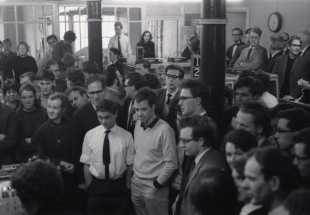
Ruth Loshak, formerly Feinstein
(Programmer 1958-60)
I worked as a programmer on EDSAC 2,
from 1958 to 1960. I shared an office with Margaret Mutch for some of that
time.
I remember my days at the Mathematical
Laboratory with great pleasure — it was a great shame that in those days
you were expected to stop working when you had a baby — otherwise I might
still be working with you. A gap of a few years made it hard to get back
into the computer world, though I did work for a time with Roy Wisbey at
the Literary and Linguistic Computing Centre. However I went into teaching
— first of all teaching Russian (I had learnt it on the job — translating
a book about the BESM computer for Prof Wilkes).
Peter Fellgett (User 1962-65)
The staff of The Mathematical Laboratory
were the guardians of what was for those days a very large, expensive and
powerful facility, yet my overwhelming memory is of their friendliness,
helpfulness and welcome. This is not to say, of course, that fools were
suffered gladly. There was a Priorities Committee that vetted jobs proposed
to be run on the machine. This no doubt did a useful job in improving ill-considered
proposals, but I never heard of anyone actually being rejected. According
to Peter Swinnerton-Dyer you had to be both stupid and arrogant, neither
alone would do it.
Judy Thomas, formerly Bowers (Operator
1961-67)
I arrived at the Mathematical Laboratory
(as the lab was called then) in August 1961 as a naive 18-year-old straight
from A-levels at school. A computer: goodness, what was that! Paper tape,
magnetic tapes - I was quite bewildered. School had taught me nothing about
these. I was used to Log tables and a slide rule - not even a calculator.
To see Dr J.C.P. Miller on his Brunsvega hand machine was amazing; how
did he turn the handle so quickly? However, I soon settled into lab life
with the help of Eric Mutch, Valerie and all the Engineers - Sid, Ken,
Pete, Wilf, and John plus others. As an operator, I was allowed, in fact
encouraged, to attend some of the Diploma students' lectures and so became
a little au fait with machine code and later Autocode.
Everyone was very friendly and,
socially, I was always very busy. My poor Mother was used to me telephoning
home to say I would be missing lunch (off to the Mill) or would be late
home for tea (off to the Eagle for a pint). Then there were the punt outings
with lab staff and students during the summer afternoons - we couldn't
all go, as someone had to look after EDSAC 2! I also remember the annual
sherry party.
Harold Gearing (Metal Box Company)
I was joint founder-editor with the
late Eric Mutch of the Computer Journal and attended in Cambridge for quarterly
meetings up to 1968-69.
Though I attended an EDSAC programming
course at Northampton College (now City University) given by Mac Bridger
and Eric Mutch, I never actually ran a program on the machine.
Stephen Parry (Diploma Student
1966-67)
As a student of the first year of the
Diploma in Computer Science (1966), I still have vivid memories of Messrs
Wilkes, Needham, Barron, Wiseman, Matthewman, Miller, and others. What
stars!
Richard Parkins (Undergraduate
1965-66)
I used EDSAC 2 at the beginning
of my undergraduate career using facilities provided for the Archimedeans'
Computer Group. My first program was written in EDSAC Autocode, and it
calculated and printed out the prime factors of an input number. Much to
my surpise it worked first try, which is probably what hooked me on computers
as a career. I don't think I have repeated that sucess since.
Index
Diploma
students in the 1960s
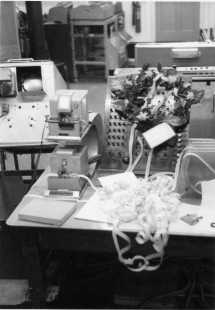
Philip Ekstrom (Diploma Student
1963-64)
I came up in 1963 for the Diploma Course
at the instigation of Norman Sanders, an earlier student in the course.
He was by then running the Computer Methods group at the Boeing Company
in Seattle, I was an undergraduate who had worked for him two summers,
and he had decided that someone should EDUCATE this brash young fellow.
My undergraduate degree was in Physics,
with a few courses in Numerical Analysis thrown in. I had experience with
the IBM 709 in assembly and Fortran, and some background in electronics.
With that preparation, student support for a year of computing preparatory
to a programme in Physics, and a new wife beside me, off I went on my first
trip across an ocean.
One surprise at the Mathematical
Laboratory, as it was then called, was a level of mathematical preparation
in my fellow students higher than I had found at home. Another was the
breadth of the programme. One lecture might be on classical numerical analysis,
perhaps followed by a practical session on interpolation with Brunsvega
barrel-style hand-cranked mechanical calculators. Another might cover compilation
techniques, and still another might be a report on the tunnel-diode logic
work then underway at the laboratory. I recall describing the programme
later as "...designed to give you the mistaken impression that you could
design a computer from scratch, build it, and program it to do anything."
The impression would be mistaken only in that what you had been taught
was how to start on those tasks and where to look for what else you would
need to know.
Much of my work with computing has
in subsequent years centred on small-embedded controllers, often part of
miniature or inexpensive field data collection devices. In many cases they
gain performance from including in the field instrument the capability
for an unusual amount of autonomous action. I find that many of the techniques
and points of style learned then, both from and on a world-class (if ageing)
central computer, go very well with today's $10 control processors.
Peter Toye (Archimedean 1963-66,
Diploma Student 1966-67)
The program in the programming class
which took an unprecedented 20 seconds to run before crashing (most of
our programs failed in microseconds). It turned out to be sorting the array
it was given, running off the end, sorting the rest of memory, wrapping
round the top, and sorting itself into order before hitting the data that
it had inserted into itself.
Returning late one evening to the
diploma students' room, seeing a light on and hearing noises. On entering,
finding Dr J.C.P. Miller working a manual Brunsvega calculator completely
engrossed in his calculations, not noticing me at all. Fingers moving at
the speed of light - I could work out some of the short cuts he was making,
others left me baffled. It was rather like watching Paganini practising.
Rachel Wroth, formerly Britton (Diploma
student 1965-66)
I had arrived in Cambridge in October
1965, with a physics degree and after a summer at CERN, the nuclear physics
centre in Geneva, where I had attended an intensive FORTRAN programming
course and helped with writing subroutines for analysing bubble chamber
photos. I had mastered a card punch machine and learned how to get their
mighty CDC machine to accept and run a box of cards.
I was astonished to find that as
a Diploma student in Cambridge, I was not expected to write programs in
a high-level language like FORTRAN (only the PDP-7 team even acknowledged
its existence, as far as I remember), and I had to write part of my dissertation
on PDP assembler code and part in Titan machine code. The whole business
of preparing and editing paper tapes seemed so ludicrously cumbersome compared
with cards. If one was winding up a long tape without due care and it got
caught round a table leg or tangled and tore, what a slow chore it was
to position the two halves on a special block with pins and splice it with
one of those little patches, using a hand punch to make the holes required
in the area of the patch!
I came to appreciate the benefits
of paper tape — much less bulky to carry around and no danger of dropping
a deck and getting cards out of order. I was introduced to the challenge
and the fun of machine code programming and remember the tense atmosphere
in the diploma students' room when the deadline for handing in dissertations
approached. One of our year, Steve Bourne, wrote a text editor which paved
the way for quicker and easier correcting of programs.
Karen Sparck-Jones (User1964
— Reader now)
The Diploma students also had their
own room in the old Lab building — and indeed in the new building until
IBM mainframes took all the space over. The students' room was on the top
floor and was furnished with old barrack room tables; it was also used
for the annual Christmas party, when the Lab was small enough to include
everyone in a get together, with competitive games like making the most
dashing newspaper hat (ladies for gentlemen).
At that time Catling's Auction Room
was in Corn Exchange Street opposite the Lab, and lots of people used to
pop down on viewing day: Lab research students setting up home could buy
carved Victorian chairs for five shillings.
Guy and Annette Haworth (Diploma
students 1968-69)
We did the Diploma course in 1968-69.
I guess our claim to fame is that, although we had both been at Oxford
on the same course before, we had never spoken. We met on the steps of
Corn Exchange Street going into register for the Diploma and got married
(a bit afterwards, of course) in Caius College. I'd like to claim that
the meeting on the steps was truly romantic, but I don't think it was —
being immediately followed by a meeting in David Hartley's office registering
for John Larmouth's FORTRAN course. We're still in computing-(ish).
Index
Titan
Titan
construction
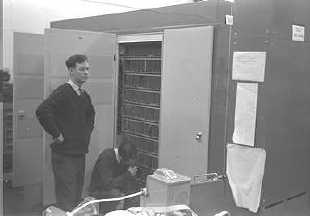
Roy Bayley (Computer Engineer
1962-73)
When Titan arrived, it was bright and
shiny and was installed in a bright and shiny air-conditioned room. You
even had to walk over sticky mats to remove grit from your shoes before
approaching the Holy Grail! However, EDSAC 2 operated a service, Titan
did not. Titan was delivered to the Maths Lab by Ferranti/ICT straight
off the production line. It had many faulty components and wiring errors.
In fact many basic instructions did not work.
With Titan came two company engineers,
Johnny and Gareth, whose task was to progress the Maths Lab team up the
learning curve. Any readers around the Lab at this time will remember their
well-deserved reputation for sinking large quantities of beer. Indeed,
Sid Barton and I were amazed how they could return from a liquid lunch
at the Eagle, having had the odd pint or five, stand swaying gently in
front of the Engineers Console and still give sound advice on fixing faults.
Faults that Sid and I were struggling to understand when sober!
Titan was a large asynchronous computer,
consisting of 6 racks, with approximately 300 boards per rack. It had thousands
of germanium transistors, tens of thousands of diodes and other discrete
components. Each board carried only a small amount of logic, so fault finding
by changing boards was of limited use. To fix faults the engineers needed
to understand the voluminous computer logic and be able to adapt the test
software to diagnose problems. It was a good learning experience. I enjoyed
this time, working with a compatible team on a large mainframe computer,
fixing different problems each day. Not so much a job, but a way of life.
If only the pesky users would stop wanting to use the machine!
Initially the Titan system had several
magnetic-tape drives, paper-tape readers, 64Kwords of RAM housed in units
the size of a double wardrobe, but no printer.
In line with the Maths Lab 'Do It
Yourself' ethos of the time, I was given the task of designing a printer
for the Computing Service. Not something to be contemplated nowadays. The
printer electronics were entirely designed and built in the Electronics
Workshop. The mechanical part of the project was designed and built by
Vic Claydon and his men in the Mechanical Workshop. Working with Vic was
easy, as he didn't need detailed drawings. Just a few sketches, a bit of
interaction and he would produce an excellent result.
The printer design used a basic
ICT665 printer mechanism and the final product could print 120 characters
per line at 600 lines/min (max) or 400-lines/min average. The printer had
a ferrite core character buffer and the character set included upper and
lower case characters, which was a real plus at the time.
The printer gave good service for
some years, the characteristic ripping sound of its print hammers being
part of the general noise of the Titan Computing Service in full flight.
Oliver Wintringham (Decca Radar)
In the sixties (1965?), I came for
a job interview that might have led to my working on Titan, but (in those
days of plentiful job offers) I eventually went elsewhere.
Richard Jennings (Diploma student
1962-63, Ferranti)
I took the Diploma course at the Laboratory
in 1962-63, and then joined Ferranti/ICT and worked on the joint Cambridge/ICT
project to develop the Titan Supervisor from 1963-65. My colleagues at
that time included David Hartley, David Barron and Peter Swinnerton-Dyer.
Brian Chapman (ICL)
I was responsible for the installation
of Fortran on Titan in early 1966. The Fortran compiler was designed by
(and implemented by a small team led by) Alec Glennie of AWRE Aldermaston
for their Atlas 2. This compiler was developed from one written earlier
for their IBM 7030 'Stretch' computer.
The compiler was embedded within
Hartran, a Fortran environment designed at AERE Harwell for their Atlas
under the direction of Dr. Ian Pyle. Hartran provided a symbolic loader
capable of combining Fortran (and potentially other) subroutines that had
been separately compiled, and was the only such system program available
on any of the Atlas family. Separate compilation was of course a natural
extension of the earlier pioneering work at Cambridge with subroutines,
and vital for any large program.
I personally had migrated the Hartran
system from Atlas to Atlas 2, having earlier written the code generation
phase of the first Atlas Fortran compiler at Harwell.
Peter Toye (Archimedean 1963-66,
Diploma Student 1966-67)
Being told, when a program had stopped
working "Oh, we changed that instruction last week, didn't you see the
notice?"
Peter Hammersley (Senior Technical
Officer 1966-69)
One day in 1967 (I think - but it may
have been 1968) I was working with Neil Wiseman on the linking to an Atlas
2 (i.e. Titan) of terminals via modems. At the time we were in touch with
Eric Thomas, who had been a research student at the Laboratory, and had
moved to the Atlas Laboratory at Chilton to work on the front ending of
terminals to the Atlas 1 via a Sigma 1 machine. We concluded that, between
the three of us, if we each set up on Atlas a simulator of a terminal we
ought to be able to make the two Atlases communicate computer to computer.
This we did, realised how clever we were, and thought no more about it
than the satisfaction of having done it. With hindsight weren't we stupid?
Richard Pankhurst
(Research Assistant 1966-71)
I remember the rebuilding of the Lion
Yard site, the ball swinging on the end of chain, the incessant pile driving.
When the New Museums site was first
built — sarcastic spirits used to say that the open area on the podium
was daft — cold and draughty (it still is), and would surely soon be filled
with temporary hutments (seems not to have happened).
Index
Titan
maintenance
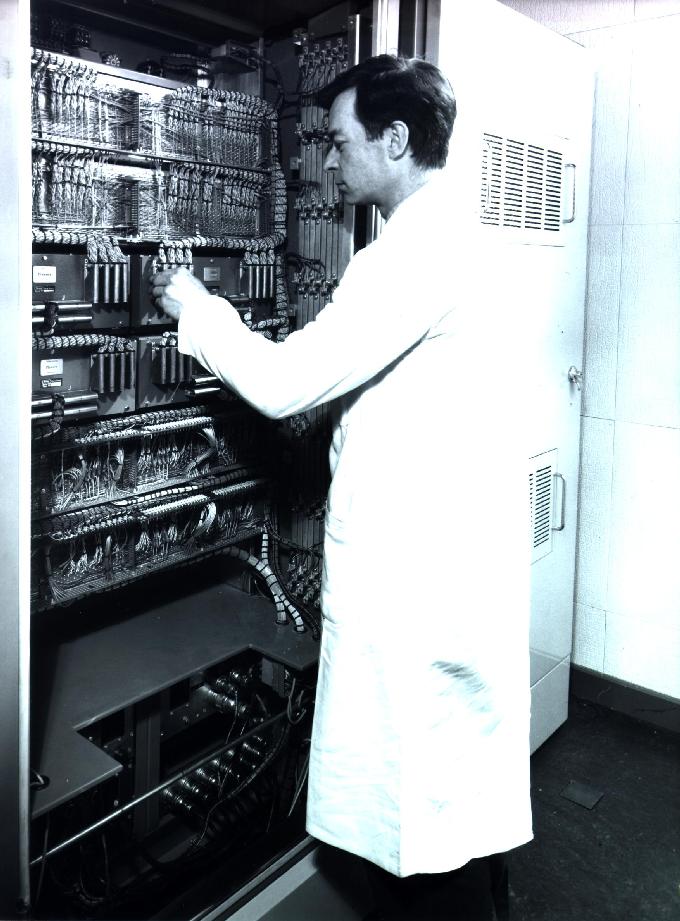
Richard Pankhurst
(Research Assistant 1966-71)
In Titan days, when the machine had
been down for repairs, there was a buzzer code which meant "operators come
running, it's back again," which had us all running to our teletypes to
log in again as fast as possible, to get the first in the processing queue.
What was the code?
Index
Titan
operating
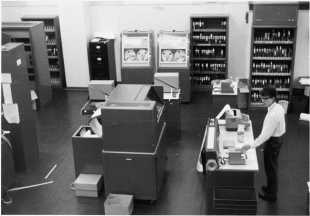
Judy Thomas, formerly Bowers (Operator
1961-67)
With the demise of EDSAC 2, Titan was
commissioned in an air-conditioned room - bliss in the heat of summer.
It was run 24 hours a day by teams of operators (many more of us now and
nearly all called Sue), and a permanent night shift. Several programs ran
in the computer at the same time, and if one went wrong, this could be
a problem to all. One program generated only blank paper tape and could
not be stopped until almost a whole reel had been used!
Philip Shaw (Operator 1967-69,
Computer Science Tripos 1972-73)
Whilst I was at the Grammar School
in Cambridge a friend got a guided tour around Titan courtesy of a member
of the Laboratory staff who knew my maths teacher. It all sounded exciting,
so I asked for a tour as well. At the end of the guided tour I had the
cheek to ask for a job and subsequently became a part-time operator on
Titan on Friday nights and some school holidays. I really enjoyed the job
and, without going into details, my appearance for the Computer Science
Tripos, meeting my wife, my career in computing, all stem directly from
the small kindness of giving a guided tour to a schoolboy!
Karen Sparck-Jones (User1964
— Reader now)
As most users were not allowed near
the Titan (shut away in its own shiny room) we submitted our jobs by putting
paper tapes in plastic bags along with colour-coded tickets e.g. pink for
large jobs (30 minutes estimated time, or needing 3 magnetic tapes). These
bags were hung on hooks on a board outside the Titan Room.
There was a cabinet with copies
of library routine tapes (on green paper) e.g. RR10 - read integer, or
PR10 - print integer, for copying into one's own program tapes.
The real gadget was the unipunch
- that neat little hand punch that you could use to add holes to soup up
one of your tape characters. Of course if there was too much hole already,
you had to patch the tape like a bicycle tube to get a smooth stretch to
punch anew.
Index
Titan
applications
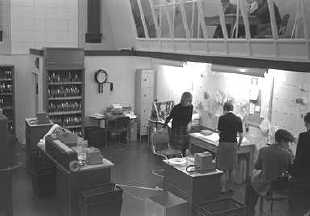
Roger Stratford (User 1963-71,
Computer Officer 1971-)
Schaefer's moved on to using the Titan
and then I think our liaison person was Janet Richards (later Linington).
Schaefer paid some nominal fee for the work! Schaefer Dielectrics had a
research contract with RRE Malvern to develop high quality microwave dielectric
materials for the radar on the ill-fated supersonic TSR2 aircraft.
About three years later, while working
for the Cambridge Instrument Company, I again used the Titan. We were developing
and running a Fortran program generating simulated microwave and infrared
spectra. The Instrument Company was just getting into spectrometers at
the time. I can recall working through the early hours of the morning because
the response was so much better than during the day - and claiming overtime
from the company, of course. The work eventually moved to the Atlas at
the CAD Centre.
Then I joined the Computing Service
at the end of 1971 and have been here ever since!
Index
Titan
people
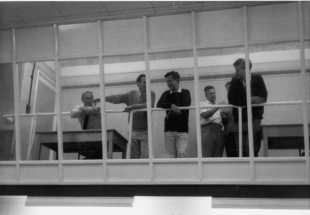
Peter Hall (ICT/ICL)
As manager of the Ferranti Computer
Department in the 1950s and 1960s, and later as a Director of ICT and ICL,
I had a long standing association with Professor Wilkes. I was responsible
for the company end of the collaboration that led to Titan.
Roy Bayley (Computer Engineer
1962-73)
It is sad that some members of the
hardware dream team are no longer with us. It is a particular tragedy that
Sid Barton was not part of the EDSAC 99 celebration. He played a valuable
part on EDSAC, EDSAC 2 and Titan. He was a good engineer, dedicated to
his work, with a rare common-sense approach to life and he had a good sense
of humour. I worked with Sid for 12 years and towards the end of the 60s
when Titan was up and running, we would tell the operators we were going
to Millers Wine Bar for a little light refreshment! Now it can be told!
We had many good chats together about computing, the possibility of Ice
Ages (no global warming worries in the 60s), religion, the meaning of life,
etc. We didn't come to any great conclusions but I still remember Sid and
my days working on Titan with great pleasure.
Karen Sparck-Jones (User1964
— Reader now)
During the work on Titan, and in it
early operational life, Roger Needham, David Hartley, Barry Landy and Mike
Guy shared a large office on the second floor of the old lab. It gradually
accumulated piles and piles of ever dustier papers, manuals, etc. There
was a lot of night work, and one morning when I went in to the office Mike
Guy rose from behind the screen of paper piles, where he had been asleep
stretched out on three chairs.
Judy Thomas, formerly Bowers (Operator
1961-67)
In 1965, I went out with one of the
Diploma students who eventually became my husband, I think he had a very
good turn round with his programs - somehow I seemed to find myself running
them out of turn! We were married in September 1967 and left to live in
Oxfordshire. I still look back on my time in Cambridge with affection.
Oliver Wintringham (Decca Radar)
In the seventies, I was one of the
speakers at a seminar on Microcode, organised by the BCS, and chaired by
Dr Wilkes. I was to give an introductory talk on Microcode and what it
is useful for, and I naturally rang Maurice for advice. He very kindly
referred me to an article in the IBM Systems Journal, which pleased and
surprised me, since I was working for IBM at the time.
John Larmouth, (Diploma student
1962-63, - Computer Officer to 1978)
I was a student on the Diploma course
around about 1963, and spent one year with the EDSAC 2. As a PhD student,
I then produced the FORTRAN compiler for the Titan, and the scheduling
system for the IBM System/370, and was on the staff for some twelve years
up to around 1978.
Karen Sparck-Jones (User1964
— Reader now)
Dedicated users from distant departments,
or ones too lowly to rate significant office space in their departments,
tended to roost permanently in the Lab, and after EDSAC 2's demise the
console floor area was taken over as a users' pound, One of the adjoining
offices was designated a Discussion Room, so people could be pushed in
there to talk without disturbing the others in the pound. Later on these
users earned a proper room on the ground floor, with lockers as well as
tables. Nearby, in the Lab's informal style, there was an unlocked cupboard
with a piece of Babbage's Analytical Engine (now firmly in the Whipple
or some other proper museum), a wonderful machined brass object that Jack
Dennis of MIT once demonstrated to me.
The old Lab building had large areas
where ordinary people never went, like the third floor workshops, and stores
with capacious shelving stacked with bins. Maybe all the engineers and
assistants were naturally like that anyway, but the Lab's build it yourself
style meant that all kinds of bits and pieces and redundant kit were kept
in case they came in handy in some way. When we finally had to clear the
old Lab there were always
people out scavenging souvenirs
from the skips. (For some, the change in computing in the years since was
poignantly marked by the reduction of the Lab workshops, especially the
mechanical one.)
Richard Parkins (Assistant in
Research 1969-72)
I later did a bit of vacation work
for the Laboratory during 1967. This would have been my first paid
employment. I think I was making some
improvements to Neil Wiseman's
Scope Editor on the PDP-7. This was the machine on which I really cut my
programming teeth, so to speak. From August 1969 until September 1972.
I was doing research into Computer-Aided Design with Charles Lang's group.
Apart from a brief interlude restoring antiques, I've been in some part
or other of the Computer industry ever since.
Peter Toye (Archimedean 1963-66,
Diploma Student 1966-67)
Marya Goldman, knee-high to a grasshopper,
shouting "You stupid machine" to the PDP-7.
Index
References
-
M.V. Wilkes, Memoirs of a Computer
Pioneer, MIT Press, 1985.
-
IEEE Annals of the History of Computing,
Special issue on the University of Cambridge, Vol. 14 (4), 1992.
-
In the Beginning - Recollections of
Software Pioneers by Robert L Glass, IEEE Computer Society�, 1998
-
Peter Naur, Impressions of the early
days of programming, BIT 20 (1980) 414-425.
Index
Contributors
The editor is grateful to the following
who submitted material for the compilation of reminiscences on the occasion
of EDSAC 99. Given against each name are the relevant dates of association
with the Laboratory and the position at that time.
| Roy Bayley |
1962-73 |
Computer
Engineer |
| Diana Belcham |
1956-57 |
Diploma
Student |
| John Bennett |
1947-50 |
Research
Student |
| David Brailsford |
- |
Nottingham
University |
| Neil Breakwell |
1948-49 |
Undergraduate |
| Brian Chapman |
- |
ICL |
| William
Cochran |
1946-64 |
User |
| Geoff Cook |
1951-53 |
User/Research
Student |
| Durward
Cruickshank |
1950 |
Summer School |
| Edsger Dijkstra |
1951 |
Summer School |
| Leonard
Dresel |
1949-52 |
User/Research
Student |
| Philip Ekstrom |
1963-64 |
Diploma
Student |
| Peter Fellgett |
1962-65 |
User |
| George Felton |
1946-51 |
Undergraduate |
| Harold Gearing |
- |
Metal Box
Company |
| Peter Gray |
1958-61 |
Undergraduate |
| Dick Grimsdale |
1950 |
Summer School |
| Peter Hall |
- |
Ferranti/ICL |
| Peter Hammersley |
1966-69 |
Senior Technical
Officer |
| Jack Harwood |
1949-50 |
User/Research
Student |
| Guy &
Annette Howarth |
1968-69 |
Diploma
Students |
| Don Hunter |
1949-51 |
Research
Assistant |
| Richard
Jennings |
1962-63 |
Diploma
Student, Ferranti |
| John Larmouth |
1962-78 |
Diploma
— Computer Officer |
| John Lennard-Jones |
- |
Son of Maths
Lab founder |
| Jenifer
Leech |
1953-56 |
User/Research
Student |
| John Lindley |
1958-59 |
Diploma
Student |
| Charles
Lindsey |
1953-56 |
Research
Student |
| Ruth Loshak |
1958-60 |
Programmer |
| Herbert Norris |
1951-63 |
Technician |
| Richard
Pankhurst |
1966-71 |
Research
Assistant |
| Richard
Parkins |
1965-66
1969-72 |
Undergraduate
Assistant in Research |
| Stephen
Parry |
1966-67 |
Diploma
Student |
| Christopher
Phelps |
|
Diploma
Student |
| Mike Pitteway |
1956-59 |
Research
Student |
| Colin Reeves |
1952-55 |
User/Research
Student |
| Philip Shaw |
1967-69 |
Operator |
| D H Shinn |
1947-50 |
User/Research
Student |
| Karen Sparck-Jones |
1964- |
User - Reader |
| Robin Stokes |
1948-49 |
User/Research
Student |
| Roger Stratford |
1963-71 |
User |
| Judy Thomas |
1961-67 |
Operator |
| Peter Toye |
1966-67 |
Diploma
Student |
| Elizabeth
Waldram |
1959-65 |
User |
| Peter Wegner |
1953-54 |
Diploma
Student |
| Donald Willis |
1948-50,
1952-55 |
Research
Assistant |
| Oliver Wintringham |
- |
Decca Radar |
| Rachel Wroth |
1965-66 |
Diploma
student |
Index
This is version 1.1 of the Reminiscences, reflecting its state on 21 July 1999.

Copyright © University of Cambridge Computer Laboratory, 1999.
All rights reserved.
Please send any comments to edsac99.

